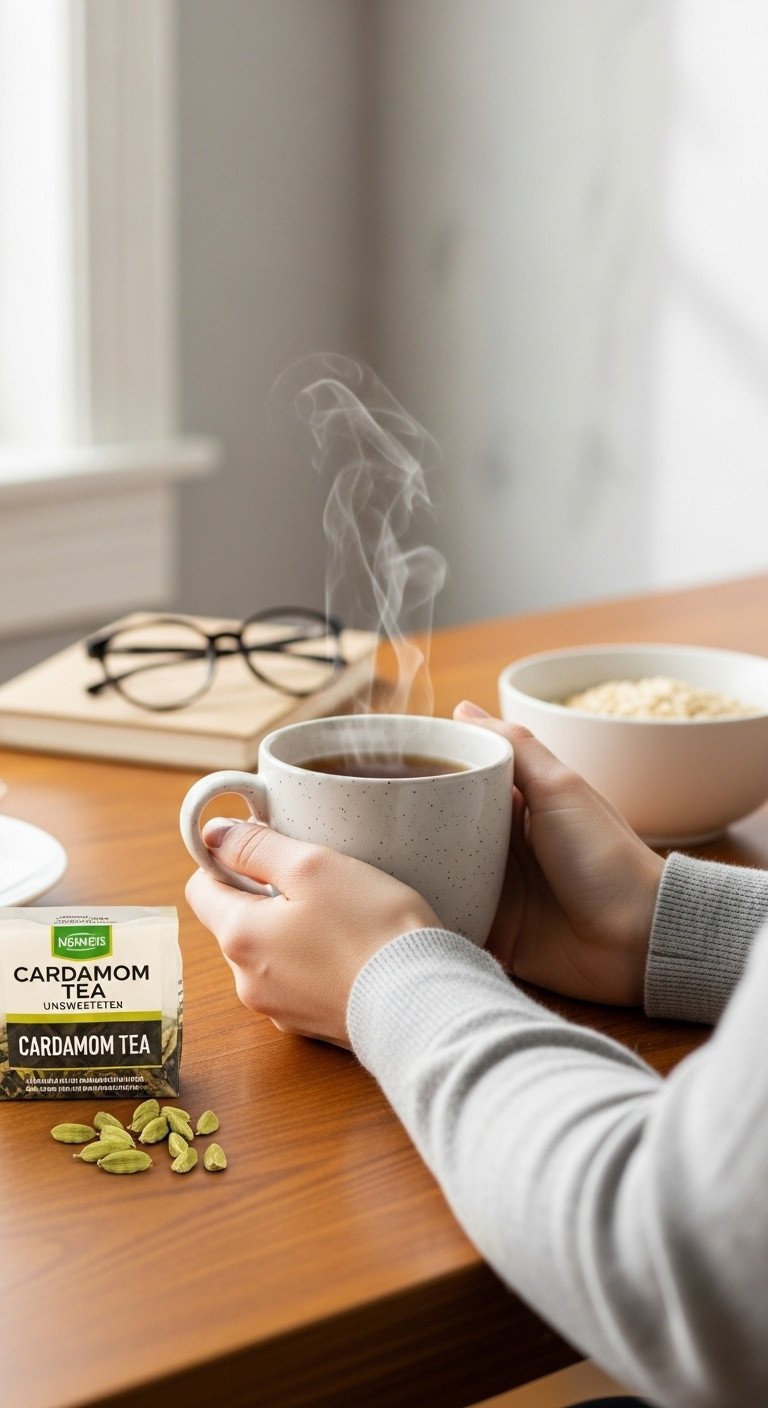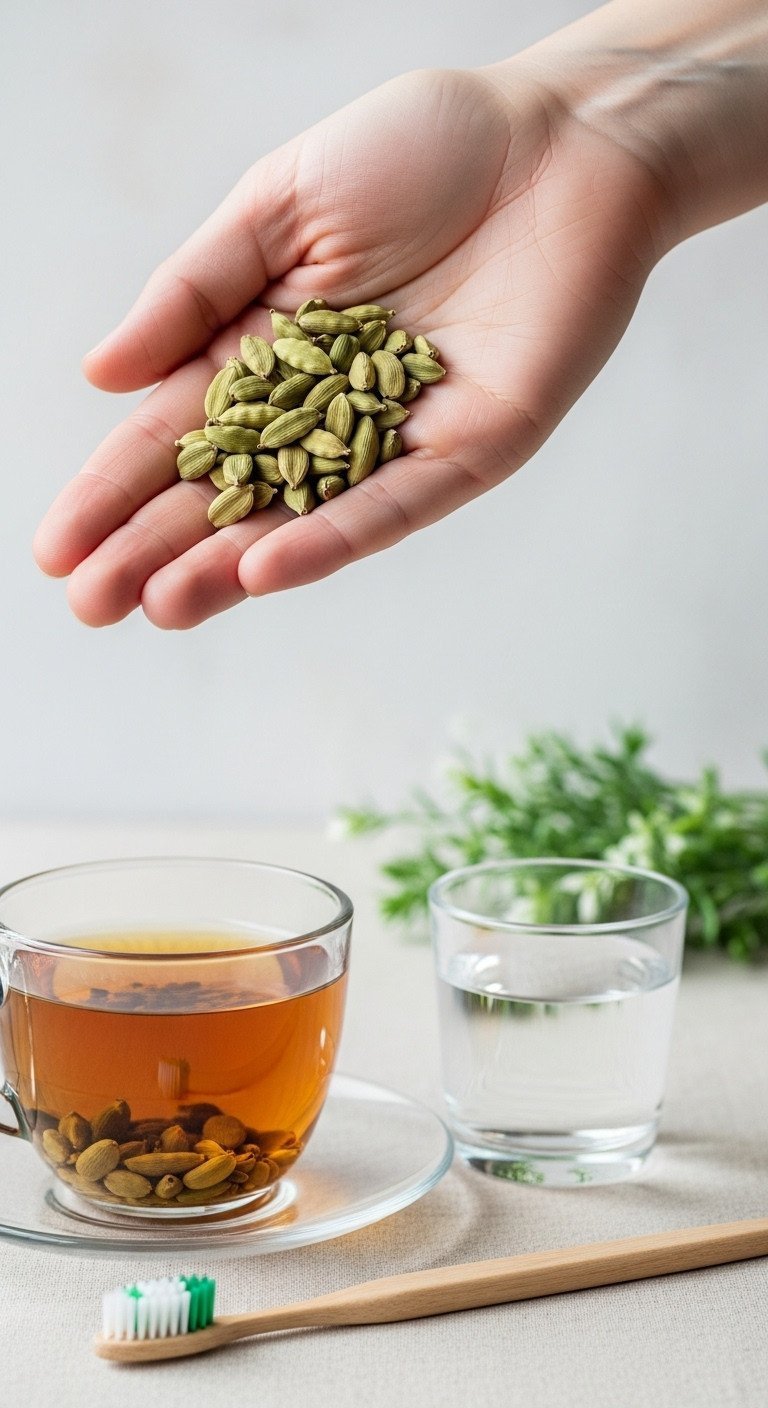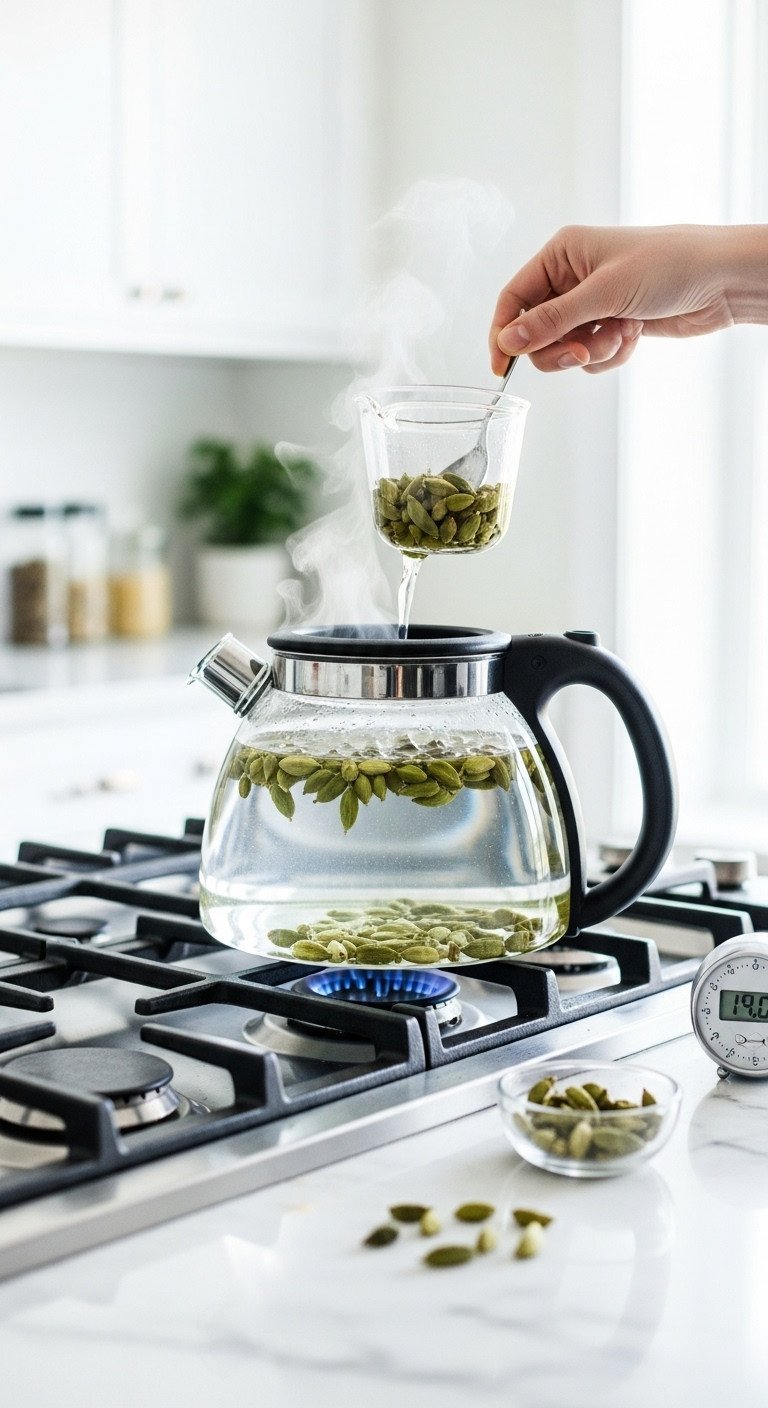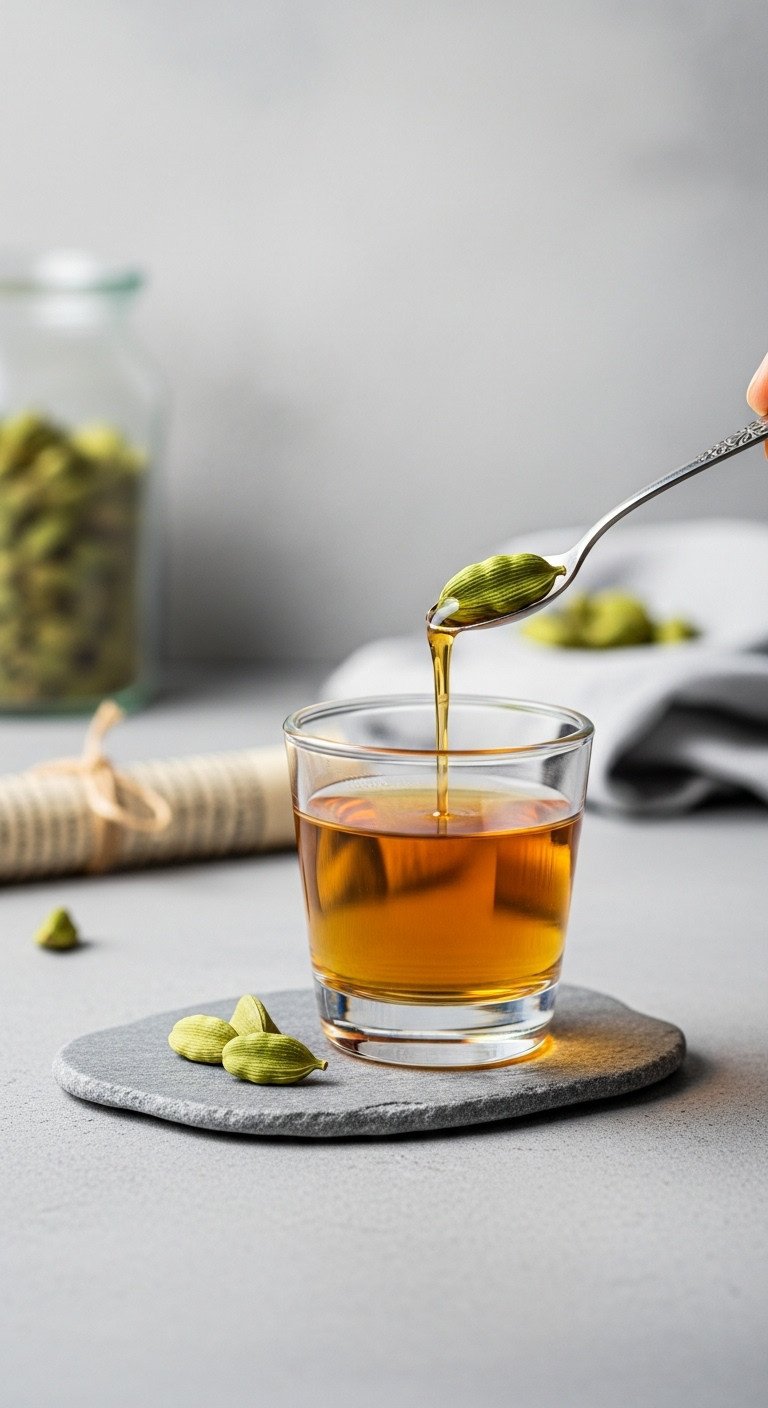As an Amazon Associate CoffeeXplore.com earns from qualifying purchases.
Cardamom Tea Ultimate Recipe Guide 7 Proven Benefits and Flavor Secrets
Struggling to get that rich, authentic flavor from your homemade cardamom tea? You’re not just brewing a drink; you’re trying to capture an ancient, aromatic experience.
Cardamom tea is a warm beverage made by infusing cardamom pods into hot water or milk. Many people find their homemade versions taste weak or watery, missing that bold, spicy-sweet character. This can be frustrating when you’re seeking comfort or health benefits.
Cardamom Tea Recipe: The secret to a perfect brew is to lightly crush whole green cardamom pods just before simmering them for 5-7 minutes to fully release their potent volatile oils. This guide will show you two foolproof methods, a simple infusion and a traditional milk chai, to unlock incredible flavor and proven health benefits every time.
Unlocking the Ultimate Cardamom Tea Recipe and Flavor Secrets
Achieving that perfect cup of warm, aromatic cardamom tea comes down to understanding two key things: the right ingredients and the right technique. The difference between a bland, watery drink and a bold, spiced beverage lies in how you treat the cardamom itself. It’s all about releasing the fragrant, volatile oils locked inside the pods. We’ll start with the foundational knowledge of crushing the pods and managing steeping time to ensure you get intense, authentic flavor from the very first cup.
The Ultimate Cardamom Tea Quick Start: Two Essential Methods
Whether you’re looking for a simple, low-calorie digestive aid or a rich, comforting chai, the preparation method is key. Both of these recipes are verified based on traditional South Asian and Middle Eastern techniques, giving you an authentic taste. You can choose the method that best fits your needs and preferences. Each recipe is broken down into two simple parts: what you need and what to do, making them incredibly easy to follow.
1. Simple Cardamom Water Infusion (The Digestive Aid)

Pin this genius tips to your ‘Healthy Drinks’ board!
This method is the quickest and healthiest way to enjoy the pure flavor and digestive benefits of cardamom. It’s perfect for after a meal or for a caffeine-free evening drink.
Materials Needed:
- 4-5 Whole Green Cardamom Pods (Elettaria cardamomum)
- 1 cup Filtered Water
- Optional: 1 Black Tea Bag or 1 tsp Loose Leaf Tea (Assam or Ceylon)
- Optional: Small amount of Honey or Stevia (for natural sweetening)
- Tool: High-quality ceramic or stone Mortar and Pestle
Step-by-Step Directions:
- Crush: Place the cardamom pods in a mortar and pestle and lightly crush them until the shells crack and the dark seeds are exposed. This step is critical for maximizing volatile oil release.
- Boil: Bring the filtered water to a rolling boil (100°C or 212°F).
- Simmer Spices: Reduce heat and add the crushed cardamom pods directly to the water. Simmer for 5-7 minutes to fully extract the oils, creating a potent infusion.
- Steep Tea Base (Optional): Remove the pot from heat and add the black tea base if you’re using it. Steep for no more than 3 minutes to avoid any bitterness.
- Strain and Serve: Pour the tea through a fine-mesh strainer into your mug, sweeten to taste, and enjoy immediately while hot.
Pro-Tip: Use a dedicated ceramic or stone mortar and pestle solely for spices to prevent flavor transfer between ingredients, ensuring the cardamom flavor remains clean and potent.
2. Authentic Cardamom Milk Chai (The Comforting Ritual)

Save this clever organization idea!
This recipe creates the rich, creamy, and robustly spiced chai that is a staple in many cultures. The synergy between the milk, spices, and black tea results in a deeply comforting and flavorful beverage.
Materials Needed:
- 6-7 Whole Green Cardamom Pods (freshly crushed)
- 1-inch piece of Fresh Ginger (thinly sliced or bruised)
- 1 cup Filtered Water
- 1 cup Whole Milk (or high-fat plant-based milk like oat or cashew)
- 2 tsp Strong Black Tea (Assam or Breakfast blend)
- Sweetener: 1 tbsp Sugar or Jaggery (optional)
Step-by-Step Directions:
- Combine Spices and Water: In a small saucepan, combine the crushed cardamom and ginger with the filtered water. Bring to a boil and then reduce the heat to a strong simmer for 3 minutes.
- Add Milk: Pour in the milk and sweetener (if using). Bring the mixture back up to a low simmer—do not allow it to boil rapidly, as this can scorch the milk.
- Add Tea: Once simmering, add the black tea leaves. Continue to simmer gently for 2-3 minutes, stirring occasionally. The mixture should take on a rich, tan color.
- Remove and Steep: Take the pot off the heat and cover it. Allow it to steep off-heat for 1 minute for a strong brew, or less for a milder one.
- Strain and Pour: Use a fine-mesh strainer to pour the chai directly into two small cups, ensuring no spice remnants are included.
Pro-Tip: Using a high-fat milk (whole dairy or creamy oat) is essential, as the volatile, fat-soluble cardamom oils dissolve better, leading to a richer, more uniform flavor distribution than watery, low-fat options.
The Science-Backed Truth: 7 Proven Benefits of Cardamom Tea
Beyond its incredible flavor, cardamom tea is a functional beverage packed with health benefits supported by both traditional use and modern science. The spice contains potent phytochemicals like cineole and various polyphenols that contribute to its therapeutic effects. Disclaimer: The information in this section is for educational purposes only and is not intended as medical advice. Always consult with a healthcare professional before using herbal remedies for health conditions.
1. Powerful Digestive and Carminative Aid

Cardamom tea is a renowned remedy for common digestive issues like bloating, gas, and indigestion. Its effectiveness comes from its natural carminative properties.
What You Need:
- Specific consumption timing (15-20 minutes post-meal)
- Unsweetened cardamom water infusion
- Consistency (daily consumption)
How It Works:
- Stimulates Gastric Secretions: The volatile oils in cardamom promote the production of stomach acid and digestive enzymes, which aids in the efficient breakdown of food.
- Carminative Action: As a potent carminative, it helps relax the smooth muscles of the digestive tract. This action prevents the formation of gas and helps relieve bloating and cramps.
- Fights Nausea: Similar to ginger, the compounds in cardamom help soothe the stomach lining, offering quick relief from mild nausea.
Lesson Learned: For maximum digestive impact, consume the tea warm and unsweetened, as sugar can sometimes exacerbate bloating in sensitive individuals.
2. Significant Anti-Inflammatory Properties

Chronic inflammation is a root cause of many diseases, and cardamom contains powerful compounds that help combat it at a cellular level.
What You Need:
- Understanding of active compounds
- Consistent daily consumption
- High-quality, fresh cardamom
How It Works:
- Polyphenol Content: Cardamom is rich in polyphenols and flavonoids. These are potent antioxidants that neutralize the free radicals that drive chronic inflammation.
- Cineole Suppression: The primary active component, 1,8-cineole, has been shown in studies to suppress the activity of inflammatory mediators in the body.
- Cellular Protection: Regular intake helps protect cells from oxidative stress damage. This reduces the overall inflammatory burden and supports long-term health.
Pro-Tip: Combining cardamom tea with other anti-inflammatory spices like ginger and turmeric creates a synergistic effect, amplifying the overall benefit.
3. Supports Cardiovascular and Heart Health

Research suggests that regular consumption of cardamom may contribute to better heart health, particularly by helping to manage blood pressure.
What You Need:
- Consistent, unsweetened daily intake
- Knowledge of blood pressure regulation
- Low-sodium diet reinforcement
How It Works:
- Potassium Rich: Cardamom contains significant amounts of potassium. This electrolyte is crucial for regulating blood pressure by counteracting sodium’s effects and helping to relax blood vessel walls.
- Diuretic Action: Studies suggest that aqueous extracts of cardamom may act as a diuretic, promoting the excretion of excess fluid and slightly reducing strain on the cardiovascular system.
- Fibrinolytic Activity: Research indicates that cardamom may support fibrinolytic activity, which helps prevent the formation of blood clots, thus contributing to better circulation.
Lesson Learned: If using a black tea base, be mindful of the caffeine content if you are sensitive to it or managing severe hypertension. For primary heart health benefits, use an herbal or rooibos base.
4. Natural Oral Hygiene and Breath Freshener

For centuries, cardamom pods have been chewed as a natural way to freshen breath. The tea offers similar benefits by targeting the root cause of oral odor.
What You Need:
- Whole cardamom pods (to chew directly)
- Unsweetened, strong cardamom tea
- Knowledge of odor-causing bacteria
How It Works:
- Antimicrobial Action: The cineole compound in cardamom exhibits strong antimicrobial activity against several strains of oral bacteria that cause bad breath (halitosis) and contribute to gum disease.
- Flavor Masking: The intense, pleasant aromatic oils immediately mask existing odors while the antimicrobial agents work to address the root cause.
- Saliva Production: The act of chewing the seeds or sipping the tea stimulates saliva flow, which naturally helps cleanse the mouth and neutralize acids.
Pro-Tip: For rapid breath freshening, simply chew 2-3 whole, high-quality cardamom seeds after a strong meal (like garlic or onion).
5. Boosts Detoxification and Liver Function

Cardamom tea can support the body’s natural cleansing processes by aiding liver function and promoting the removal of toxins.
What You Need:
- Consistent source of water-based tea
- Hydration (drinking enough water alongside tea)
- Overall healthy diet
How It Works:
- Diuretic Effect: By promoting urination, cardamom tea helps the body flush out water-soluble toxins and waste products more efficiently.
- Enzyme Activation: Some studies suggest cardamom may support liver enzymes responsible for Phase I and Phase II detoxification pathways.
- Antioxidant Protection: The high antioxidant load protects the liver cells from damage caused by free radicals and environmental toxins during the cleansing process.
Lesson Learned: Cardamom tea aids the body’s natural detoxification system, but it is not a “detox drink” that replaces organ function; use it as a supportive, healthy ritual.
6. Supports Blood Sugar Management and Lipid Profiles

As part of a balanced diet, unsweetened cardamom tea may play a supportive role in maintaining healthy metabolic function.
What You Need:
- Strictly unsweetened tea base
- Consultation with a healthcare provider
- Use in conjunction with a balanced diet
How It Works:
- Glucose Metabolism: Certain compounds in cardamom may help improve glucose tolerance and inhibit specific enzymes related to carbohydrate metabolism, leading to better blood sugar management.
- Lipid Reduction: Research suggests that cardamom consumption can have a positive effect on lipid profiles, potentially reducing levels of LDL (bad) cholesterol and triglycerides.
- Synergy with Cinnamon: When paired with cinnamon, as it often is in chai, the combination of spices provides an amplified effect on supporting healthy insulin sensitivity.
Pro-Tip: If using cardamom tea for metabolic support, it is absolutely vital to ensure the recipe is sugar-free or uses only very low-glycemic natural sweeteners like stevia, otherwise the benefit is negated.
7. Promotes Anti-Cancer and Chemopreventive Activities

Emerging research highlights the potential for cardamom’s potent phytochemicals to support cellular health and offer chemopreventive effects.
What You Need:
- High concentration of active compounds
- Continuous research monitoring
- General nutritional awareness
How It Works:
- Antioxidant Defense: The incredibly high level of antioxidants helps protect cellular DNA from damage, which is a key first step in cancer prevention.
- Apoptosis Induction: Preliminary in vitro and animal studies suggest that cardamom extracts may induce apoptosis (programmed cell death) in certain cancer cells.
- Toxin Inhibition: The spice may help inhibit certain enzyme activities that can activate carcinogens, offering a preventative mechanism.
Lesson Learned: While promising, this research focuses on high-concentration extracts, not tea alone. Cardamom tea should only be used as a supportive dietary component and never as a replacement for conventional medical treatment.
Flavor Secrets: Green vs. Black Cardamom & Sourcing Guide
The single biggest factor influencing your tea’s flavor is the type and quality of the cardamom you use. Understanding the difference between the two main varieties—green and black—is essential for crafting the perfect cup and avoiding unwanted flavors. This sourcing guide will help you choose the right spice for your recipe.
Green Cardamom (Elettaria) vs. Black Cardamom (Amomum)
Most recipes call for green cardamom, but knowing the alternative is key to mastering the spice. Here is a clear comparison to guide your choice.
Comparison Framework:
| Feature | Green Cardamom (Elettaria) | Black Cardamom (Amomum) |
|---|---|---|
| Flavor Profile | Bright, highly aromatic, floral, slightly citrusy, spicy-sweet | Smoky, earthy, pungent, camphorous, less sweet |
| Typical Use | Chai, desserts, coffee, light spice blends, simple tea infusions | Savory dishes, robust curries, Kashmiri Kahwa, strong chai |
| Color/Appearance | Small, vibrant green, plump pods | Large, dark brown/black, rugged pods |
| Drying Method | Air-dried or sun-dried | Dried over a fire (imparting smoke) |
| Tea Recommendation | Standard cardamom tea, milk chai | Robust, smoky chai variations or coffee |
Mastering Flavor Extraction: Crush, Simmer, and Steep
Getting intense flavor isn’t magic; it’s brewing science. The potent aromatic compounds in cardamom are volatile oils locked inside the seeds. To make exceptional tea, you must follow a specific protocol to release them effectively.
Volatile Oil Release Protocol:
- The Crush is Mandatory: You must lightly crush the pods just before use, exposing the dark, sticky seeds inside. If the pod remains whole, the hot water cannot access and extract the potent volatile oils.
- Simmer the Spices: Unlike delicate tea leaves, the tough, crushed pods require both heat and time. A 5-7 minute simmer in water or milk is necessary to fully release the oils, which are protected by the shell and seed coating.
- Steep Tea Base Separately: To avoid a bitter, tannic tea, add the black tea leaves or bags only during the last 2-3 minutes of the process. This allows you to steep them gently in the already-spiced liquid base.
Dosage, Safety, and YMYL Considerations
While cardamom tea is a healthy beverage for most people, it’s important to be aware of safe consumption levels and potential contraindications. As this beverage has potential health impacts, it falls under YMYL (Your Money or Your Life) considerations, requiring a cautious and well-informed approach.
Safe Daily Dosage and Consumption Frequency
Daily consumption of cardamom tea is generally considered safe and beneficial in moderation. For most healthy adults, 1-2 cups of tea prepared with the standard ratio (4-6 pods per liter) is appropriate. Excessive intake (more than 4-5 cups daily) may occasionally cause mild gastrointestinal irritation due to the concentration of volatile oils. Always introduce cardamom slowly into your routine, especially if using a highly concentrated water infusion.
Warnings, Side Effects, and Contraindications
Side effects are rare, but consumption should be approached with caution in specific cases. Individuals with gallstone issues should consult a physician, as cardamom may trigger colic. It is crucial to limit intake or consult a doctor if you are pregnant or breastfeeding, as high doses of any herbal compound are typically discouraged. Cardamom may also interact with certain anti-clotting or blood-thinning medications; always check with a healthcare professional regarding potential drug interactions.
Key Takeaways: Your Quick Guide to Aromatic Brewing
To quickly review the most important points for making perfect cardamom tea every time, keep these five essential tips in mind.
Key Cardamom Tea Tips:
- The Pod is Key: Always use fresh, whole green cardamom pods, and crush them just before brewing—never use pre-ground powder for the best flavor.
- Simmer for Flavor: Boil the crushed spices in the water or milk base for 5-7 minutes before adding the black tea leaves to ensure full oil extraction.
- Check Your Base: Use strong black tea (Assam or Ceylon) for the best balance, or a caffeine-free rooibos base for health-focused, evening consumption.
- Digestive Timing: Consume unsweetened water-infused cardamom tea 15-20 minutes after a meal to maximize its carminative and anti-bloating effects.
- Know the Types: Green cardamom provides a bright, floral flavor (for most recipes); black cardamom provides a smoky, intense flavor (use sparingly).
People Also Ask About Cardamom Tea
Does Cardamom Tea contain caffeine?
The cardamom spice itself is entirely caffeine-free, but most traditional recipes use a black or green tea base which contains caffeine. To make a pure, caffeine-free cardamom tea, substitute the base with an herbal tea like rooibos or simply use hot water for a pure spice infusion, ideal for evening consumption.
How do I prevent my cardamom tea from tasting weak or watery?
Weak flavor is almost always caused by not properly crushing the pods or not simmering them long enough. Ensure the pods are physically cracked open using a mortar and pestle just before brewing. Then, simmer the crushed pods in the liquid base for a full 5-7 minutes before adding any black tea leaves for a potent flavor.
What is the Ayurvedic perspective on drinking cardamom tea?
In Ayurvedic tradition, cardamom is highly valued as a tridoshic spice, balancing all three doshas (Vata, Pitta, and Kapha). It is primarily used to stimulate Agni (digestive fire), reduce mucus/phlegm (Kapha), and calm bloating/gas (Vata). It is often consumed after meals to prevent indigestion and purify the mouth and breath.
What is the optimal temperature and steeping time for cardamom tea?
For maximum flavor, the crushed cardamom pods should be simmered in water or milk at 100°C (212°F) for 5-7 minutes. If using a black tea base, the tea leaves themselves should be steeped separately, at a slightly lower temperature (95°C or 203°F) for only 2-3 minutes, as over-steeping the leaves causes bitterness.
Final Thoughts
Cardamom tea is far more than just a pleasant beverage; it is a time-honored elixir that offers incredible functional benefits when brewed correctly. By applying the ultimate flavor secrets—using whole, freshly crushed pods, simmering the spices first, and paying attention to timing—you can easily create a powerful infusion at home. We encourage you to try the unsweetened water infusion after your next heavy meal and experience the subtle, natural digestive relief for yourself.
What is your favorite method for crushing cardamom: mortar and pestle or the back of a spoon? Share your secret spice tips in the comments below
Last update on 2025-12-05 / Affiliate links / Images from Amazon Product Advertising API

